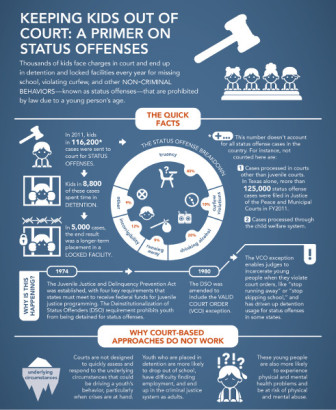This article was originally published on CitiesSpeak.org:
Last week, Sen. Sheldon Whitehouse, D-R.I., and Sen. Charles Grassley, R-Iowa, introduced the Juvenile Justice and Delinquency Prevention Reauthorization Act of 2014. The Juvenile Justice and Delinquency Prevention Act (JJDPA) provides state and local government agencies with federal standards and supports for juvenile justice and delinquency prevention.
Of high interest to cities are three key changes to the way state and local governments address and treat young people. The proposed bill would:
- Remove a loophole that allows juvenile courts to detain youth for non-criminal acts;
- Give local and state governments more guidance on understanding and reducing racial and ethnic disparities; and
- Require several evidence-based steps to reduce the harm the juvenile justice system does to many young people.
National League of Cities’ new municipal action guide, "Increasing Public Safety and Improving Outcomes for Youth through Juvenile Justice Reform," documents steps cities can take ahead of these proposed changes to the law.
Repeating the same mistake doesn’t equal lockup
Parents know that kids and teens usually need to be told something more than once in order to get them to change their behavior. “If I have to tell you one more time …” One proposed change to the JJDPA would ask courts to give youth under court supervision for noncriminal acts the same chances.
If approved, the JJDPA would require juvenile systems to phase out the use of incarceration for repeated noncriminal status offenses, such as running away, "incorrigibility" and skipping school. This would keep about 8,800 youth annually who are currently detained for repeating the same mistake out of detention and in their homes, schools and communities. This change will not affect young people under the court’s supervision who are charged with actual crimes.
Ample evidence that shows incarcerating youth increases the risk they will drop out of school, have trouble finding a job and be incarcerated as adults. Based on this evidence, the current JJDPA already prohibits juvenile agencies from putting youth charged with status offenses in detention. Instead, courts put those youth under supervision in the community and, typically, place requirements on them. For example, the court will order a truant youth to attend school every day.
Making the same mistake again then violates that court order — something for which the current JJDPA allows detention. The proposed change would require juvenile courts and agencies to hold youth accountable for these violations without detaining them.
Often, what works best to hold youth accountable and change their behavior will be something in the young person’s neighborhood and community. Cities that have a robust continuum of community-based services, much like the services outlined in the guide, will see better outcomes for these 8,800 or more youth.
Reducing racial and ethnic disparities
Evidence shows that racial and ethnic disparities have persisted in the state and local agencies responsible for juvenile justice, including in arrests by local law enforcement agencies. The proposed JJDPA requires juvenile justice systems to use data-driven policies and programs to ensure fairness in their decisions about youth. It also asks states to establish measurable goals for reducing disparities across the system and to share their goals and progress with the public. In our guide, we share Tucson, Ariz.’s data-driven response to racial disparities in their arrests of youth, which trains patrol officers to use an objective, decision-making tool at the point of arrest.
Do no (or less) harm
Judges and other juvenile justice professionals haven’t adopted the Hippocratic oath of our medical colleagues, but perhaps we should. Based on evidence of significant harm to and subsequent negative outcomes for youth in incarceration, the revised JJDPA would take several steps to reduce the severity and risks of incarceration to young people.
The bill protects youth from being incarcerated with adults while awaiting trial and encourages states to use effective behavior modification techniques in juvenile facilities as an alternative to isolation and physical restraint practices. The bill also promotes accountability of state juvenile justice agencies by requiring more public reporting. Important to cities, it also reauthorizes the Juvenile Accountability Block Grant, which states may distribute to localities to support juvenile justice programs.
Laura E. Furr is the senior associate for juvenile justice reform in the National League of Cities’ Institute for Youth, Education, and Families.



Pingback: December 23rd Summary | Corrections Reform Newswire